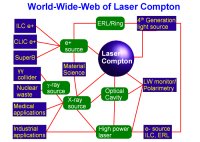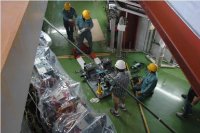 |
 |
|||||||||||||
|
|||||||||||||
|
|||||||||||||
|
The R&D for an ILC positron source using a laser-compton scheme is ongoing around the world. The efforts in Europe and Asia complement each other. In Europe, scientists are pursuing R&D for the laser path stacking cavity, a complicated, highly sophisticated system with four mirrors. In Asia, scientists aim to accumulate experience in gamma ray generation with simpler cavity structures. They also want to gain experience in installing these cavities into damping rings with high quality beams without degrading its quality. In a laser-compton scheme for the ILC, a pulsed laser beam is shot onto electron bunches. The bunches then emit powerful photons which convert into pairs of polarised electrons and positrons when they hit a tungsten target. Using the same technology, various beams can be produced, such as soft X-ray, hard X-ray, and gamma ray. “I think the studies on the Compton positron source could play an important role in the engineering design phase as a very attractive alternative scheme,” says Tsunehiko Omori of KEK, who leads the Asian Compton positron source study. Because of the wide range of possibilities for the application, it has a tight connection with other fields, making it possible to bring new researchers to the ILC. Omori believes that the R&D could also influence a wide variety of people beyond the intitial research. “If the studies for the ILC contribute to other fields, people who benefit could become supporters to build the proposed project. This possibility will be one of the best ways to promote the ILC in the engineering design phase,” he says. According to Omori, laser-compton could have a large potential as a future technology. Applications could range from medical uses and life sciences to semiconductors, magnetic material, and processing of nuclear waste. “We call it the World-Wide Web of laser-compton,” says Omori. A standard chest X-ray, for example, exposes patients to high levels of radiation. This is because of the quality of the X-ray that is currently used. With the laser-compton technology, Omori explains, a much clearer X-ray image could be obtained, decreasing the patient's radiation exposure. Omori says that it could also be useful for angiograms, a cardiac procedure that uses a catheter to inject a dye directly into the patient’s coronary arteries to check for blockages or other abnormalities. “High-quality X-rays from laser-compton make it possible to have an angiogram with a simple injection of a contrast dye,” says Tohru Takahashi of Hiroshima University, one of the scientists in the Asian team, who underwent an angiogram himself two years ago. Instead of using a catheter, which can be uncomfortable for patients, a small quantity of dye would be injected intravenously. According to Takahashi, this new way of administering angiograms could occur in the future because of the laser-compton technology’s ability to produce clear X-ray images. Some of the applications for using high-quality X-rays are already under investigation at such big facilities as Spring 8, a synchrotron radiation facility located in Hyōgo Prefecture, Japan. Many Japanese manufacturers and universities use this facility for materials analysis and biochemical protein characterisation. Experimental opportunities for industry are limited and also expensive. Industry needs to have their products tested numerous times before commercialisation is an option. “It is possible for each company to have their own test facility with the laser-compton application,” says Omori. The first test cavity for a compton positron source has been installed into KEK's Accelerator Test Facility, and the test with gamma rays is expected to start next spring. -- Rika Takahashi |
|||||||||||||
| © International Linear Collider |

